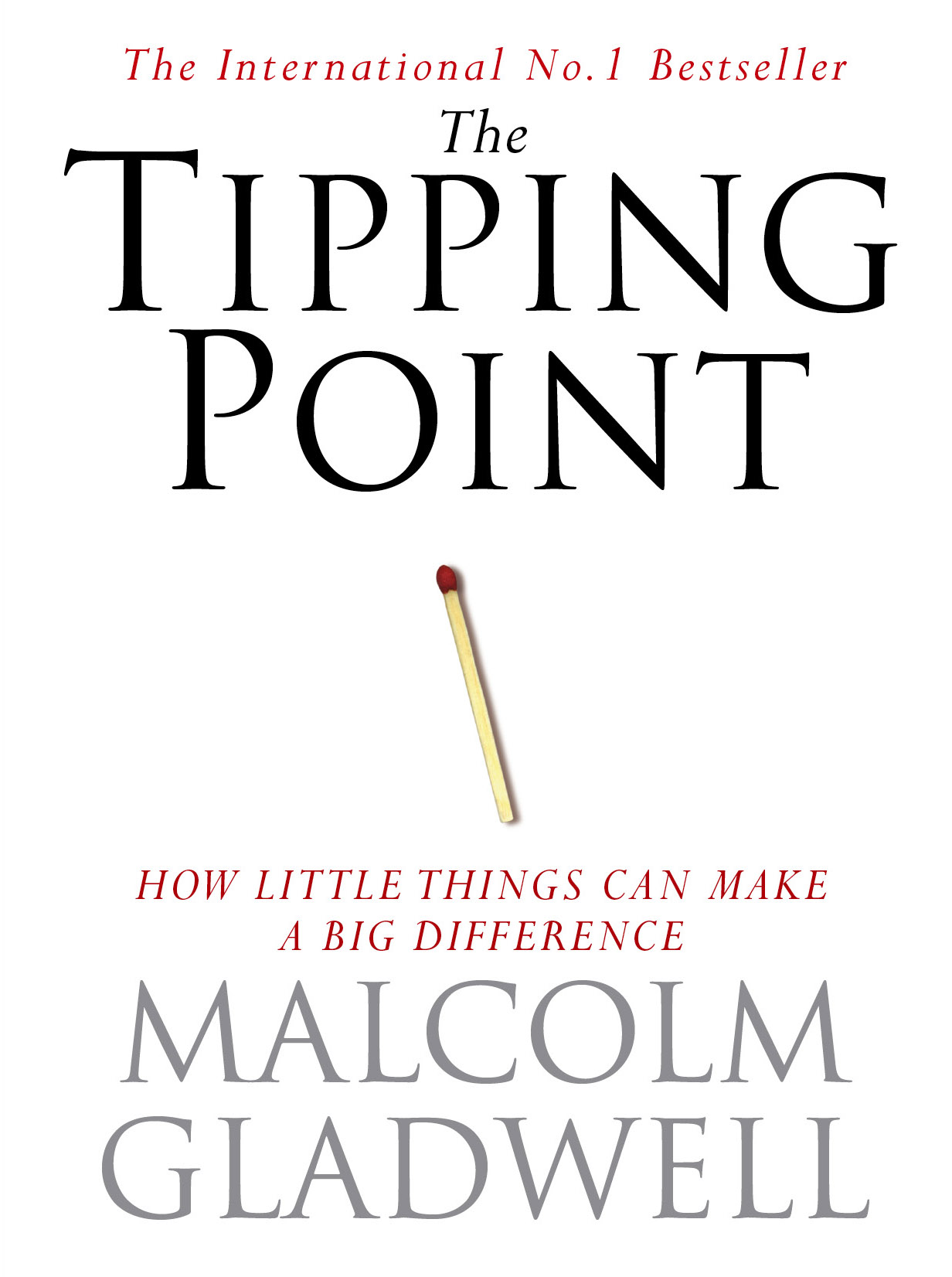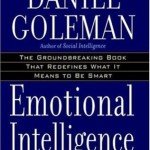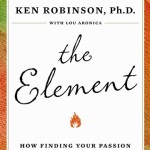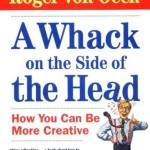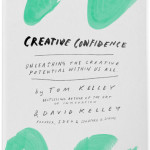The tipping point is that magic moment when an idea, trend, or social behavior crosses a threshold, tips, and spreads like wildfire. Just as a single sick person can start an epidemic of the flu, so too can a small but precisely targeted push cause a fashion trend, the popularity of a new product, or a drop in the crime rate. This widely acclaimed bestseller, in which Malcolm Gladwell explores and brilliantly illuminates the tipping point phenomenon, is already changing the way people throughout the world think about selling products and disseminating ideas.
Gladwell introduces us to the particular personality types who are natural pollinators of new ideas and trends, the people who create the phenomenon of word of mouth. He analyzes fashion trends, smoking, children’s television, direct mail, and the early days of the American Revolution for clues about making ideas infectious, and visits a religious commune, a successful high-tech company, and one of the world’s greatest salesmen to show how to start and sustain social epidemics. [From: www.goodreads.com]
Malcolm Gladwell describes the “three rules of epidemics” (or the three “agents of change”) in the tipping points of epidemics.
The Law of the Few
“The Law of the Few”, or, as Malcolm Gladwell states, “The success of any kind of social epidemic is heavily dependent on the involvement of people with a particular and rare set of social gifts”. According to Malcolm Gladwell, economists call this the “80/20 Principle, which is the idea that in any situation roughly 80 percent of the ‘work’ will be done by 20 percent of the participants”. These people are described in the following ways:
-
- Connectors are the people in a community who know large numbers of people and who are in the habit of making introductions. A connector is essentially the social equivalent of a computer network hub. They usually know people across an array of social, cultural, professional, and economic circles, and make a habit of introducing people who work or live in different circles. They are people who “link us up with the world…people with a special gift for bringing the world together”. They are “a handful of people with a truly extraordinary knack [… for] making friends and acquaintances”. Malcolm Gladwell characterizes these individuals as having social networks of over one hundred people. To illustrate, he cites the following examples: the midnight ride of Paul Revere, Milgram’s experiments in the small world problem, the “Six Degrees of Kevin Bacon” trivia game, Dallas businessman Roger Horchow, and Chicagoan Lois Weisberg, a person who understands the concept of the weak tie. Gladwell attributes the social success of Connectors to the fact that “their ability to span many different worlds is a function of something intrinsic to their personality, some combination of curiosity, self-confidence, sociability, and energy”.
-
- Mavens are “information specialists”, or “people we rely upon to connect us with new information.” They accumulate knowledge, especially about the marketplace, and know how to share it with others. Gladwell cites Mark Alpert as a prototypical Maven who is “almost pathologically helpful”, further adding, “he can’t help himself”. In this vein, Alpert himself concedes, “A Maven is someone who wants to solve other people’s problems, generally by solving his own”. According to Gladwell, Mavens start “word-of-mouth epidemics”[9] due to their knowledge, social skills, and ability to communicate. As Malcolm Gladwell states, “Mavens are really information brokers, sharing and trading what they know”.
-
- Salesmen are “persuaders”, charismatic people with powerful negotiation skills. They tend to have an indefinable trait that goes beyond what they say, which makes others want to agree with them. Malcolm Gladwell’s examples include California businessman Tom Gau and news anchor Peter Jennings, and he cites several studies about the persuasive implications of non-verbal cues, including a headphone nod study (conducted by Gary Wells of the University of Alberta and Richard Petty of the University of Missouri) and William S. Condon’s cultural microrhythms study.
The Stickiness Factor
The specific content of a message that renders its impact memorable. Popular children’s television programs such as Sesame Street and Blue’s Clues pioneered the properties of the stickiness factor, thus enhancing the effective retention of the educational content in tandem with its entertainment value.
The Power of Context
Human behavior is sensitive to and strongly influenced by its environment. As Malcolm Gladwell says, “Epidemics are sensitive to the conditions and circumstances of the times and places in which they occur”. For example, “zero tolerance” efforts to combat minor crimes such as fare-beating and vandalism on the New York subway led to a decline in more violent crimes city-wide. Gladwell describes the bystander effect, and explains how Dunbar’s number plays into the tipping point, using Rebecca Wells’ novel Divine Secrets of the Ya-Ya Sisterhood, evangelist John Wesley, and the high-tech firm W. L. Gore and Associates. Malcolm Gladwell also discusses what he dubs the rule of 150, which states that the maximum number of individuals in a society or group that someone can have real social relationships with is 150. [From: Wikipedia.com]
This book brought lots of intuitiveness and insight into the world of marketing. Looking at the different spectrum that are compared and how one can tie them together was quite ingenious. Specifically looking at “rules of epidemics” and the content that makes these rules is fascinating. The law of the few was right on; it described how connectors, mavens, and salesmen are the key to the development. Whether dealing with an outbreak or marketing ploy. From there we entered into “the stickiness factor” or the ability to get something to stick in one’s mind. How clever and insightful this was blew me away. The correlation between Sesame Street (a show I watched as a child) and Blue’s Clue’s (a show I watched with my children) was extremely relatable and clearly evident to me as I read. The power of context I struggled with a little, when Gladwell contends that the small changes in the environment affected the crime at a higher level I have to admit I was somewhat skeptical. I can’t see how cracking down on graffiti and other small violations is going to have a major effect on major crimes, don’t misunderstand me I am not disagreeing just have a hard time seeing it. However the power of context I did find rather intriguing was group size of a 150. With the less being more closely tied to idea, project, or topic, while it clearly starts to fade when the group size exceeds 150. The Airwalk shoe example was something I could relate to personally, I vividly remember my older brother being extremely excited about his rare, cool than yours, custom shoes. I also remember my first pair of Airwalks and how they were run of the mill, same as the next guys and the comment my brother made as those are so yesterday as he strutted around in his Vans which were the next cool thing. The book in all was very well written and very easy to relate to ones personal life and even at times I was emerged in the book trough the products and case studies suggested and how they tied me, the reader, into the book. I never felt like I was on the outside looking in and always felt like I was on the inside track with an advantage to see things with the author’s unique way of displaying them. I would highly recommend this book to anyone looking for a business / marketing edge as a tool to catapult the individual to a better understanding of the need for the three rules Gladwell described. [From: www.contemporarylit.about.com]If you like this story, CLICK HERE to join the tribe of success-minded people just like you. You will love our weekly quick summaries of top stories, talks, books, movies, music and more with handy downloadable guides, cheat sheets, cliffs notes and quote books.
And, you can opt-out at any time – no strings, promise… CLICK HERE
